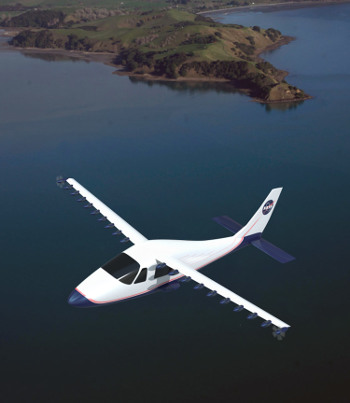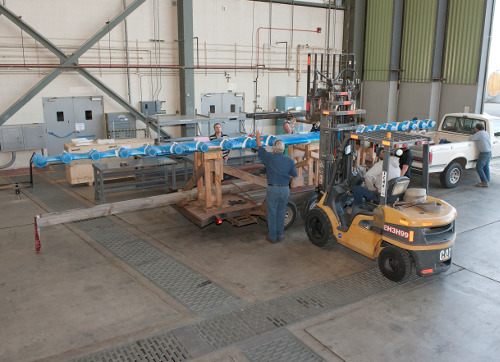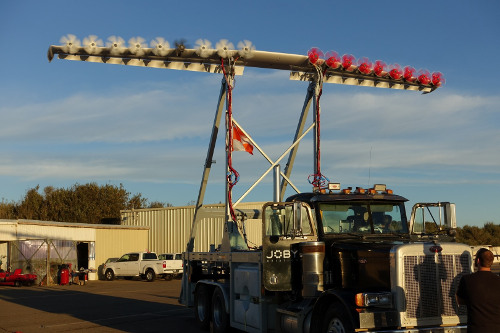 |
| March 24, 2015 | Volume 11 Issue 12 |
Designfax weekly eMagazine
Archives
Partners
Manufacturing Center
Product Spotlight
Modern Applications News
Metalworking Ideas For
Today's Job Shops
Tooling and Production
Strategies for large
metalworking plants
Wings:
NASA tests experimental wing for aircraft powered by electric motors
By Peter Merlin, NASA Armstrong Flight Research Center

NASA is working on a piloted X-plane test vehicle that replaces the wings and engines of a Tecnam P2006T with an improved version of the LEAPTech wing featuring 18 electric motors. [Image Credit: NASA Graphic]
The arrival of a unique experimental demonstrator at NASA Armstrong Flight Research Center on Feb. 26, 2015, may herald a future in which many aircraft are powered by electric motors. The Leading Edge Asynchronous Propeller Technology (LEAPTech) project will test the premise that tighter propulsion-airframe integration, made possible with electric power, will deliver improved efficiency and safety, as well as environmental and economic benefits. Over the next several months, NASA researchers will perform ground testing of a 31-ft-span, carbon composite wing section with 18 electric motors powered by lithium iron phosphate batteries.
The experimental wing, called the Hybrid-Electric Integrated Systems Testbed (HEIST), is mounted on a specially modified truck. Testing on the mobile ground rig assembly will provide valuable data and risk reduction applicable to future flight research.

Technicians unload the LEAPTech experimental wing upon its arrival at NASA Armstrong Flight Research Center. Ground testing will begin after the wing is mounted on a specially modified truck. [Image Credit: NASA Photo/Tom Tschida]
Instead of being installed in a wind tunnel, the HEIST wing section will remain attached to load cells on a supporting truss while the vehicle is driven at speeds up to 70 mph across a dry lakebed at Edwards Air Force Base in Southern California. Preliminary testing, up to 40 mph, took place in January at Oceano County Airport on California's Central Coast.

Mounted on a specially modified truck, the LEAPTech ground-test article, or Hybrid-Electric Integrated Systems Testbed, will be driven at speeds up to 70 mph across a dry lakebed at Edwards Air Force Base. Last December, it underwent preliminary testing at Oceano, CA. [Image Credit: Joby Aviation]
The LEAPTech project began in 2014 when researchers from NASA Langley Research Center and Armstrong partnered with two California companies, Empirical Systems Aerospace (ESAero) in Pismo Beach and Joby Aviation in Santa Cruz. ESAero is the prime contractor for HEIST responsible for system integration and instrumentation, while Joby is responsible for design and manufacture of the electric motors, propellers, and carbon fiber wing section.
The truck experiment is a precursor to a development of a small X-plane demonstrator proposed under NASA's Transformative Aeronautics Concepts program. Researchers hope to fly a piloted X-plane within the next couple years after removing the wings and engines from an Italian-built Tecnam P2006T and replacing them with an improved version of the LEAPTech wing and motors. Using an existing airframe will allow engineers to easily compare the performance of the X-plane with the original P2006T.
Each motor can be operated independently at different speeds for optimized performance. Key potential benefits of LEAPTech include decreased reliance on fossil fuels, improved aircraft performance and ride quality, and aircraft noise reduction.
LEAPTech is a key element of NASA's plan to help a significant portion of the aircraft industry transition to electrical propulsion within the next decade. According to Mark Moore, an aerodynamicist at Langley, "LEAPTech has the potential to achieve transformational capabilities in the near term for general aviation aircraft, as well as for transport aircraft in the longer term."
Published March 2015
READER FEEDBACK
Ben: Perhaps fun for hobbyists and LSAs but a dead end street for practical aviation. Batteries begin to decline in power output the instant they begin to do work, typically useless for power applications by the time they are 1/3 exhausted. Hydrocarbon fuels retain full power output until the very last drop that reaches the engine. And batteries have weight. The battery load required to keep an aircraft in the air for any useful amount of time would be too heavy to allow the aircraft to take off. If there turns out to be an aerodynamic advantage from the many small propellers at the leading edge of the wing, perhaps they could use a diesel generator onboard to provide power -- after calculating the aerodynamic gain against the inherent efficiency loss in the electrical power process.
DDS: An interesting approach to an all electric powered aircraft, indeed. Ben is correct in that the batteries in the aircraft supplying the power to the aircraft has some detrimental features. However; if liquid methanol were used as the fuel to 'fuel cells' that would provide the electric power to the motors, that could be an entirely different approach to so called Green Aircraft! And, a new approach too.
Ben: Direct methanol is an interesting fuel cell technology. But there are several inherent drawbacks which make it an unlikely candidate for powering an aircraft's electric motors -- low fuel efficiency, low wattage output per weight unit, temperature/pressure requirements vs. conditions at altitude, system complexity, etc. Advancements in the technology could perhaps eventually overcome some of these problems, but not enough, I think, for practical aviation applications.
JC: The article doesn't stress this but it is referred to as a Hybrid electric plane, suggesting it something akin to a flying Prius--depleting its battery for high energy tasks like takeoff then using some other power source (a gas turbine perhaps?) for its steady state needs.
Rate this article
View our terms of use and privacy policy
